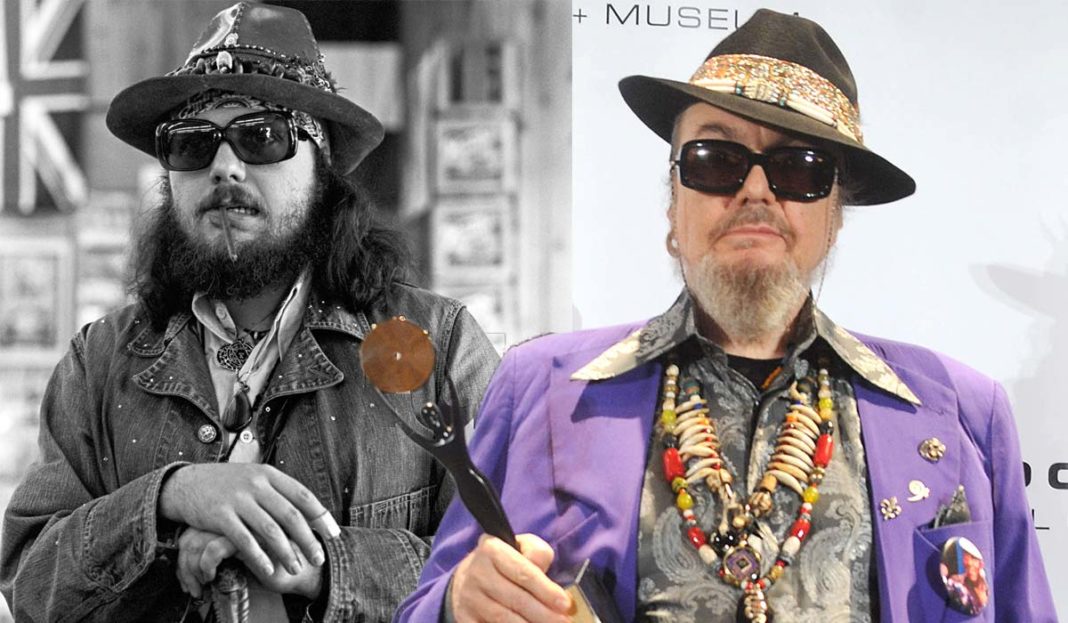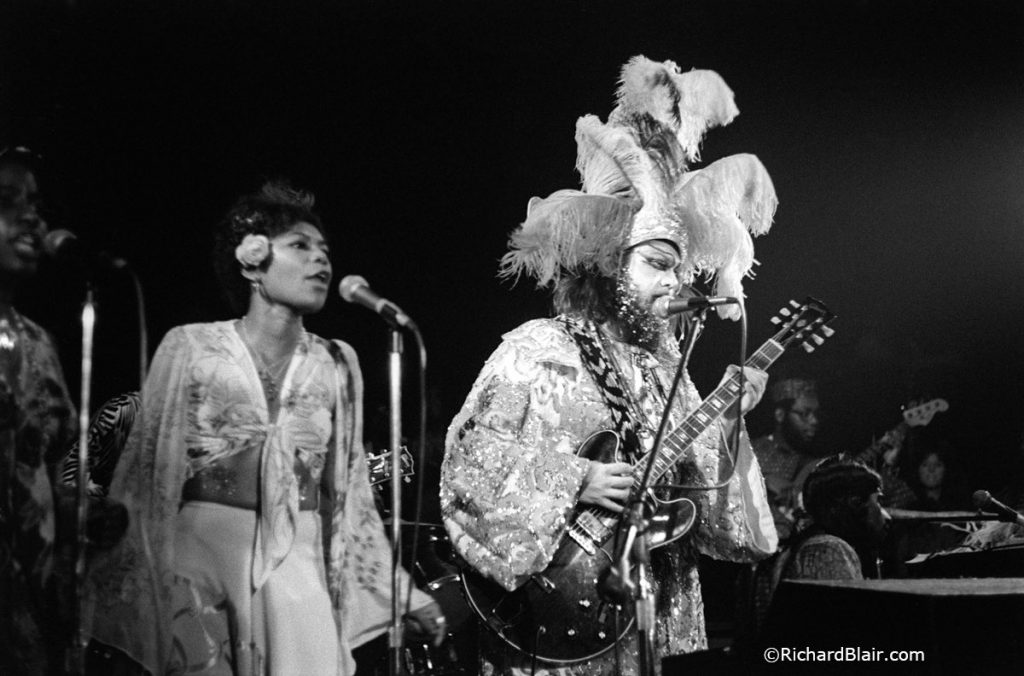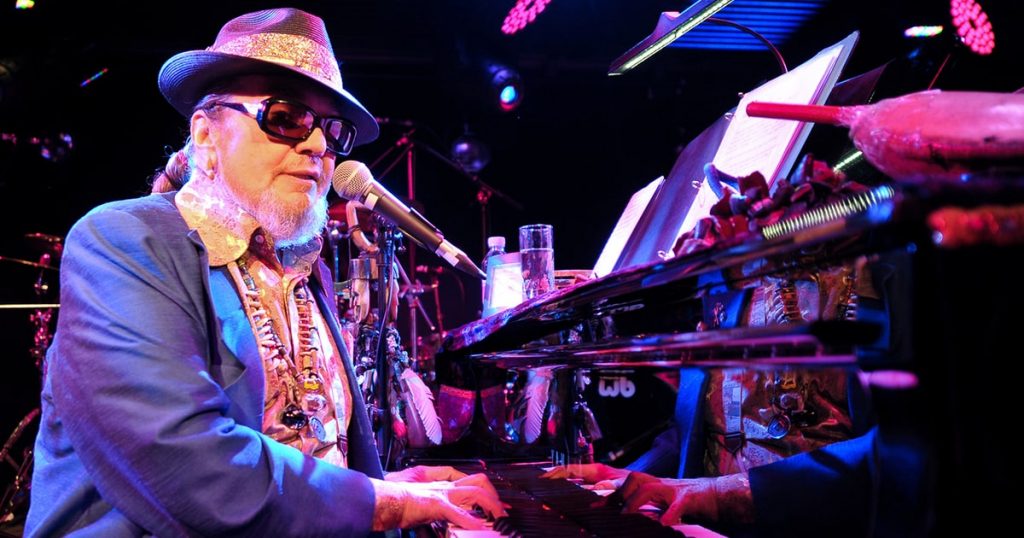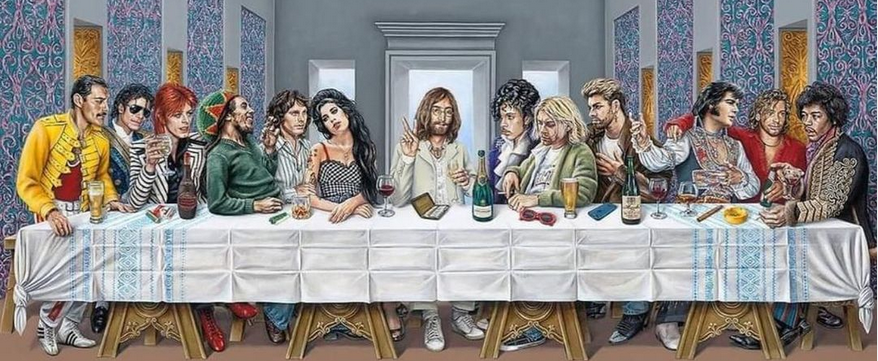
Dr. John (November 20, 1941 – June 6, 2019) was born Malcolm John Rebennack and was an American singer and songwriter. His music combined blues, pop, jazz, boogie-woogie and rock and roll.
Malcolm (Mac) John Rebennack was born in New Orleans on November 20, 1941 of French heritage. Growing up in the 3rd Ward, he found early musical inspiration in the minstrel tunes sung by his grandfather and a number of family members who played piano. His father was the owner of an appliance store and record shop and exposed him as a young boy to jazz musicians King Oliver and Louis Armstrong, who later inspired Ske-Dat-De-Dat: The Spirit of Satch which was release in 20014.
Throughout his adolescence his father’s connections gave him access to the recording rooms of rock artists, including Little Richard and Guitar Slim. Later he began to perform in New Orleans clubs, mainly on guitar, and played on stage with various local artists.
When he was about 13 years old, Dr. John met Professor Longhair. Impressed by the professor’s flamboyant attire and striking musical style, Dr. John soon began performing with him, and began his life as a professional musician.
At the age of just 16 Dr. John was hired by Johnny Vincent as a producer at Ace Records where he gained experience working with many artists, including James Booker and Earl King. While a struggling student at Jesuit High School, he was already playing in night clubs, something the Jesuit fathers disapproved of. They told him to either stop playing in clubs or leave the school so Dr. John left school and focused entirely on music.
In late 1950s New Orleans, Dr. John gigged with local bands including Mac Rebennack and the Skyliners, Frankie Ford and the Thunderbirds, and Jerry Byrne and the Loafers. He had a local hit with a Bo Diddley-influenced instrumental called “Storm Warning” on Rex Records in 1959.
Dr. John’s career as a guitarist was stunted around 1960, when the ring finger on his left (guitar fretting) hand was injured by a gunshot during an incident at a Jackson, Mississippi gig. After the injury, Dr. John concentrated on bass guitar before finally making the piano his main instrument and developing a style influenced by Professor Longhair.
Dr. John became involved in illegal activities in New Orleans, using and selling narcotics and running a brothel, and was arrested on drug charges and sentenced to two years in a federal prison at Fort Worth, Texas. When he was released in 1965 and he left for Los Angeles.
Once settled in Los Angeles he became a “first call” session musician in the Los Angeles studio scene in the 1960s and 1970s and was part of the so-called “Wrecking Crew” stable of studio musicians. He provided backing for Sonny & Cher, for Canned Heat on their albums Living the Blues (1968) and Future Blues (1970), and for Frank Zappa and the Mothers of Invention on Freak Out! (1966).
As a young man Dr. John was interested in New Orleans voodoo, and in Los Angeles he developed the idea of the Dr. John persona for his old friend Ronnie Barron, based on the life of Dr. John, a Senegalese prince, a medicinal and spiritual healer who came to New Orleans from Haiti. This free man of color lived claimed to have 15 wives and over 50 children (Poor man!). He kept an assortment of snakes and lizards, along with embalmed scorpions and animal and human skulls, and sold gris-gris, voodoo amulets that protected the wearer from harm.
Dr. John decided to produce a record and a stage show based on this concept, with Dr. John serving as an emblem of New Orleans heritage. Initially the plan was for Barron to front the act assuming the identity of “Dr. John”, while Rebbenack worked behind the scenes as Dr. John’s writer/musician/arranger/producer, but Barron dropped out of the project, and Rebennack took over the role and identity of Dr. John.

Beginning in the late 1960s, he gained fame as a solo artist after adopting the persona of “Dr. John, The Night Tripper”. Dr. John’s act combined New Orleans-style rhythm and blues with psychedelic rock and elaborate stage shows that bordered on voodoo religious ceremonies, including elaborate costumes and headdress.
In 1970, when Howard Smith asked him where the name “Dr. John the Night Tripper” came from, he responded, “Before that I was Professor Bizarre. Cats used to call me things like “Bishop” or “Governor” or somethin’ but they started callin’ me “Doctor” for a while, so I just hung it on myself for keeps.”
On the earliest Dr. John records, the artist billing was “Dr. John, The Night Tripper”, while the song writing credits billed him as “Dr. John Creaux”. Within a few years the “Night Tripper” subtitle was dropped, and Dr. John resumed using his real name (Malcolm John Rebennack) for writing and producing/arranging credits.
Gris-Gris, his 1968 debut album which combined voodoo rhythms and chants with the New Orleans music tradition, was ranked 143rd on Rolling Stone′s “The 500 Greatest Albums of All Time” list. Three more albums, Babylon (1969), Remedies (1970) and The Sun, Moon, and Herbs (1971), were released in the same vein as Gris-Gris.
By the time The Sun, Moon, and Herbs was released, he had gained a notable cult following, which included artists such as Eric Clapton and Mick Jagger, who both took part in the sessions for the album which served as a transition from his Night Tripper voodoo, psychedelic persona to one more closely associated with traditional New Orleans R&B and funk. His next album, Dr. John’s Gumbo proved to be a landmark recording and is one of his most popular to this day.
1972’s Dr. John‘s Gumbo, on which he covered several New Orleans R&B standards with only one original, is considered a cornerstone of New Orleans music. In his 1994 autobiography, Under a Hoodoo Moon, Dr. John wrote “In 1972, I recorded Gumbo, an album that was both a tribute to and my interpretation of the music I had grown up with in New Orleans in the late 1940s and 1950s.
I tried to keep a lot of little changes that were characteristic of New Orleans, while working my own funknology on piano and guitar.” The lead single from the album, “Iko Iko”, broke into the Billboard Hot 100 singles chart, eventually reaching number 71.
With Gumbo, Dr. John expanded his career beyond the psychedelic voodoo music and theatrics which had driven his career since he took on the Dr. John persona, although it has always remained an integral part of his music and identity. It was not until 1998’s Anutha Zone that he again concentrated on this aspect of his music wholly for a full album.
“After we cut the new record”, he wrote, “I decided I’d had enough of the mighty-coo-de-fiyo hoodoo show, so I dumped the Gris-Gris routine we had been touring with since 1967 and worked up a new act—a Mardi Gras revue featuring the New Orleans standards we had covered in Gumbo.”
In 1973, with Allen Toussaint producing and The Meters backing, Dr. John released the seminal New Orleans funk album In the Right Place. In the same way that Gris-Gris introduced the world to the voodoo-influenced side of his music, and in the manner that Dr. John’s Gumbo began his career-long reputation as an esteemed interpreter of New Orleans standards, In the Right Place established Dr. John as one of the main ambassadors of New Orleans funk.
Dr. John said “The album had more of a straight-ahead dance feel than ones I had done in the past, although it was still anchored solid in R&B.” It rose to number 24 on the Billboard album chart. In July 1973, the single “Right Place Wrong Time” peaked at number 9 on the Billboard Hot 100 singles chart, as well as peaking at number 19 on the Hot Soul Singles chart. It is still in heavy rotation on most classic rock stations and remains his most recognized song.
Dr. John attempted to capitalize on In the Right Place’s successful formula, again collaborating with Allen Toussaint and The Meters, for his next album, Desitively Bonnaroo which was released in 1974. Although similar in feel to In the Right Place, it failed to catch hold in the mainstream as its predecessor had done.
It did produce the single “(Everybody Wanna Get Rich) Rite Away,” which peaked at number 92 on the Billboard Hot 100 chart, and to date is the last time he hit the Hot 100. It was his last pure funk album until 1994’s Television, although like his voodoo and traditional New Orleans R&B influences, funk has continued to heavily influence most of his work to the present day, especially in his concerts.
In the mid-1970s Dr. John began an almost 20-year-long collaboration with writer Doc Pomus, to create songs for Dr. John’s releases City Lights and Tango Palace, and for the legendary blues guitarist B.B. King’s There Must Be a Better World Somewhere, which won a Grammy for Best Ethnic or Traditional Recording in 1982.
On Thanksgiving Day 1976 Dr John performed “Such a Night” at the farewell concert for The Band, which was filmed by Martin Scorsese and released as The Last Waltz. In 1979, he collaborated with the legendary Professor Longhair on Fess’s (another nickname for Henry Byrd) last recording Crawfish Fiesta, as a guitarist and co-producer. The album was awarded the first W.C. Handy Blues Album of the Year in 1980, and was released shortly after Longhair’s death in January 1980.
By the mid-1970s, Dr. John began focusing on a blend of music that touched on blues, New Orleans R&B, Tin Pan Alley standards and much more. In 1975 Hollywood Be Thy Name was recorded live at Cherokee Studios in Los Angeles, California with the studio transformed into a New Orleans nightclub for the sessions. In 1981 and 1983, Dr. John recorded two solo piano albums for the Baltimore-based Clean Cuts label. In these two recordings he played many of his own boogie-woogie compositions.
Dr. John was also a prominent session musician throughout his career. He played piano on the Rolling Stones’ 1972 song “Let It Loose”, and backed Carly Simon and James Taylor in their duet of “Mockingbird” in 1974, and Neil Diamond on Beautiful Noise in 1976. He was co-producer on Van Morrison’s 1977 album A Period of Transition and also played keyboards and guitar. He played keyboards on the highly successful 1979 solo debut album by Rickie Lee Jones.
He toured with Willy DeVille and contributed to his albums Return to Magenta (1978), Victory Mixture (1990), Backstreets of Desire (1992), and Big Easy Fantasy (1995). In 1997 he contributed piano and vocals to the Spiritualized song “Cop Shoot Cop” which appears on their album, Ladies and Gentlemen We Are Floating in Space.
His music was also featured in many films, including “New Looks” in National Lampoon’s European Vacation in 1985 and “Such a Night” in Colors in 1988. In 1992, he released the album Goin’ Back to New Orleans, which included many classic songs from New Orleans and many great New Orleans-based musicians, such as Aaron Neville, the Neville brothers, Al Hirt and Pete Fountain, backed up him on this album.
Dr. John also provided vocals for Popeyes Chicken & Biscuits’ “Luv dat chicken …” jingle, as well as the theme song (“My Opinionation”) for the early-1990s television sitcom Blossom. A version of “Do You Know What It Means To Miss New Orleans” with Harry Connick, Jr. was released on Connick’s album 20 in 1990.
His movie credits included Martin Scorsese’s documentary The Last Waltz, in which he joined the Band for a performance of his song “Such a Night”, the 1978 Beatles-inspired musical “Sgt. Pepper’s Lonely Hearts Club Band”, and Blues Brothers 2000, in which he joined the fictional band the Louisiana Gator Boys to perform the songs “How Blue Can You Get” and “New Orleans”.
His version of the Donovan song “Season of the Witch” was also featured in this movie and on the soundtrack. In 1996, he performed the song “Cruella de Vil” during the end credits of the film 101 Dalmatians.
He wrote and performed the score for the film version of John Steinbeck’s Cannery Row released in 1982. His hit song “Right Place Wrong Time” was used extensively in the movies Dazed and Confused, Sahara and the series American Horror Story: Coven. Dr. John was also featured in several video and audio blues and New Orleans piano lessons published by Homespun Tapes.
Between July and September 1989, Dr. John toured in the first Ringo Starr & His All-Starr Band, alongside Levon Helm, Rick Danko, Nils Lofgren, Jim Keltner, Joe Walsh, Billy Preston and Clarence Clemons. The tour produced the 1990 live album Ringo Starr and His All-Starr Band.
In 1997, he appeared on the charity single version of Lou Reed’s “Perfect Day”.
In September 2005, he performed Bobby Charles’ “Walkin’ to New Orleans”, to close the Shelter from the Storm: A Concert for the Gulf Coast telethon for the relief of Hurricane Katrina victims, following the devastation of his hometown of New Orleans. In November 2005, he released a four-song EP, Sippiana Hericane, to benefit New Orleans Musicians Clinic, Salvation Army, and the Jazz Foundation of America.
On February 5, 2006, he joined fellow New Orleans native Aaron Neville, Detroit resident Aretha Franklin and a 150-member choir for the national anthem at Super Bowl XL as part of a pre-game tribute to New Orleans. On February 8, 2006, he joined Allen Toussaint, Bonnie Raitt, The Edge, and Irma Thomas to perform “We Can Can” as the closing performance at the Grammy Awards of 2006.
On May 12, 2006, Dr. John recorded a live session at Abbey Road Studios for the TV series Live from Abbey Road. His performance was aired alongside those of LeAnn Rimes and Massive Attack on the Sundance Channel in the USA and Channel 4 in the UK. He has performed the opening theme music to the PBS children’s program Curious George, broadcast since 2006.
Dr. John moved back to Louisiana in 2009.
In the 2009 Disney film The Princess and the Frog, Dr. John sang the opening tune, “Down in New Orleans”. He reigned as King of the Krewe du Vieux for the 2010 New Orleans Mardi Gras season. In June 2010, he played at the Glastonbury festival, in the UK.
Dr. John played keyboards and had a major role in shaping Gregg Allman’s 2011 album Low Country Blues, which was produced by T-Bone Burnett. In 2011, he collaborated with Hugh Laurie on the song “After You’ve Gone” on Laurie’s album Let Them Talk.
Also in 2011, Dr. John, Allen Toussaint and The Meters performed Desitively Bonnaroo at the Bonnaroo Music and Arts Festival in Manchester, Tennessee, as part of the festival’s tenth year celebration. The name of the festival was taken from the 1974 Dr. John album, Desitively Bonnaroo. The same year he was inducted into the Rock & Roll Hall of Fame along with Neil Diamond, Alice Cooper, Darlene Love and Tom Waits.
In 2012, Dr. John released Locked Down, a collaboration with Dan Auerbach of The Black Keys, who produces and plays guitar. The album received very positive reviews for its raw, Afrobeat-influenced soundand won a Grammy Award, as did Auerbach for producing.
In 2014, Dr. John released a Louis Armstrong tribute album, Ske-Dat-De-Dat: The Spirit of Satch, on Concord Records USA and Proper Records in Europe. Dr. John described the inspiration of the album as Louis Armstrong coming to him in a dream and telling him “do my music your way”.
The Los Angeles Times said, “Tribute albums come and go, but it’s a real rarity that can snap a listener to attention like Dr. John’s new salute to jazz founding father Louis Armstrong.” That spring, “The Musical Mojo of Mac”, a New Orleans concert to honor Dr. John, was introduced by Brian Williams and kicked off by Bruce Springsteen singing “Right Place, Wrong Time”, with Dr. John and an all-star band which included event producer Don Was on bass.
From 2014 to 2016, Dr. John performed with The Nite Trippers, including at a Hollywood Bowl tribute “Yes We Can Can” for his late friend Allen Toussaint on July 20, 2016. Also performing Allen Toussaint compositions were New Orleans artists Irma Thomas, Cyril Neville, the band Galactic, and the Allen Toussaint Band.
In 2016, double album and DVD of the concert, The Musical Mojo of Dr. John: Celebrating Mac and his Music, was released.
In 2017, Dr. John was a headliner on The Last Waltz 40th Anniversary Tour with Music Directors Warren Haynes and Don Was, reprising his “Such a Night” performance from the original concert and film with The Band.
On November 1, 2017, Dr. John celebrated Mac Month as proclaimed by the New Orleans City Council in a reception at Napoleon House, and his birthday was proclaimed Dr. John Day in the City of New Orleans for the fact that he “rose to international recognition for his musical funkitude in performing, writing and producing.” Louisiana Governor John Bel Edwards also issued a Statement of Recognition to Dr. John for “embodying the culture of the state from New Orleans to the Bayou.”

Dr. John had a heroin addiction but, in December 1989, he completed his final rehabilitation stint and remained addiction free the rest of his life.
He was married twice and told the New York Times that he had “a lot” of children.
On June 6, 2019, Dr. John died of a heart attack.
He had recorded 32 studio albums and 6 live albums, as well as contributing to thousands of other musicians’ recordings, was the winner of six Grammy Awards, was inducted into the Rock and Roll Hall of Fame by singer John Legend in March 2011, and received an honorary doctorate of fine arts from Tulane University in May 2013.
Check out Dr John on Amazon
If you found this article interesting why not share it with your friends and family, and check out more about other Musicians who died in 2019.
.


Pingback: Musicians who died in 2019 | Dead Musicians